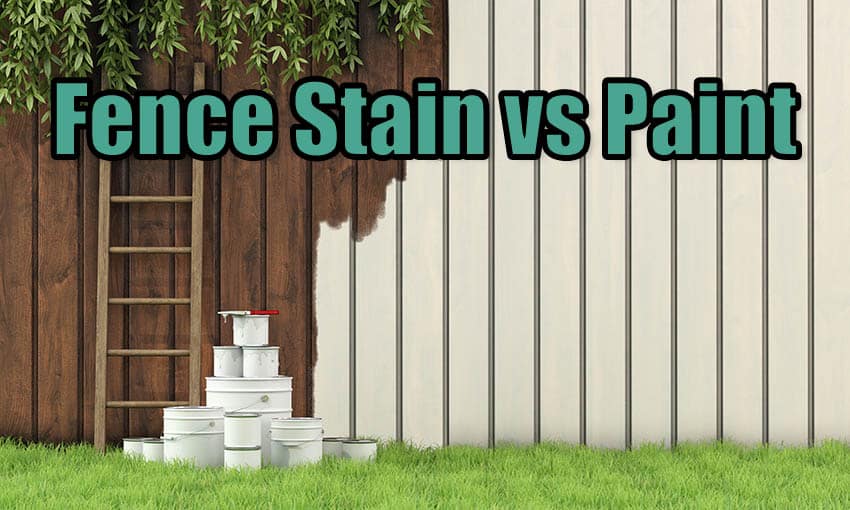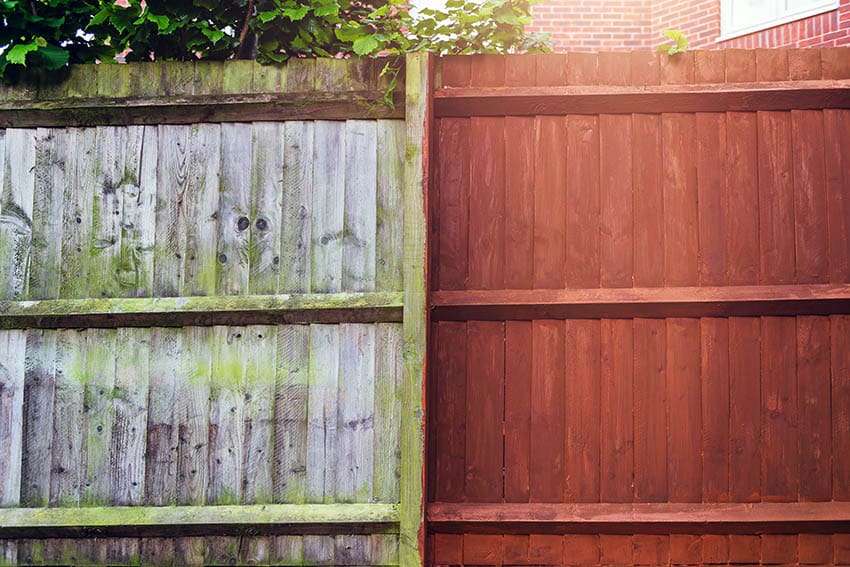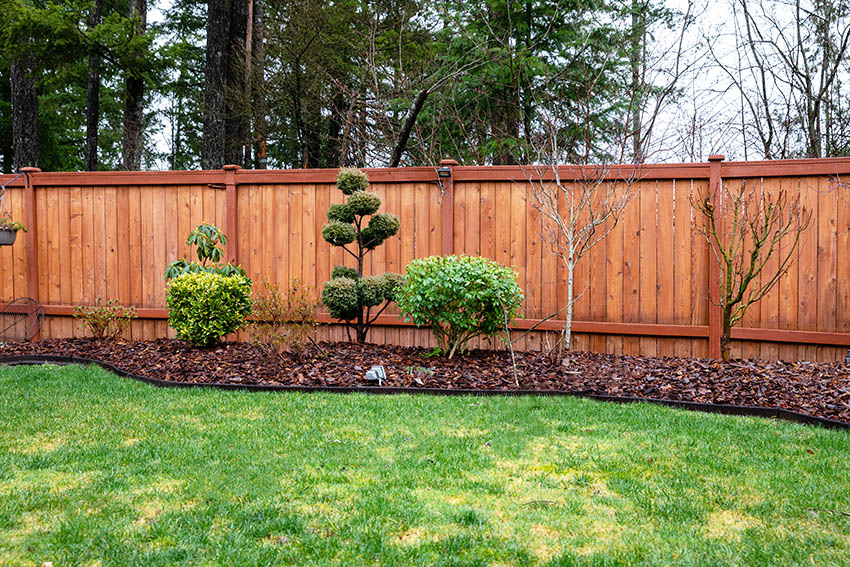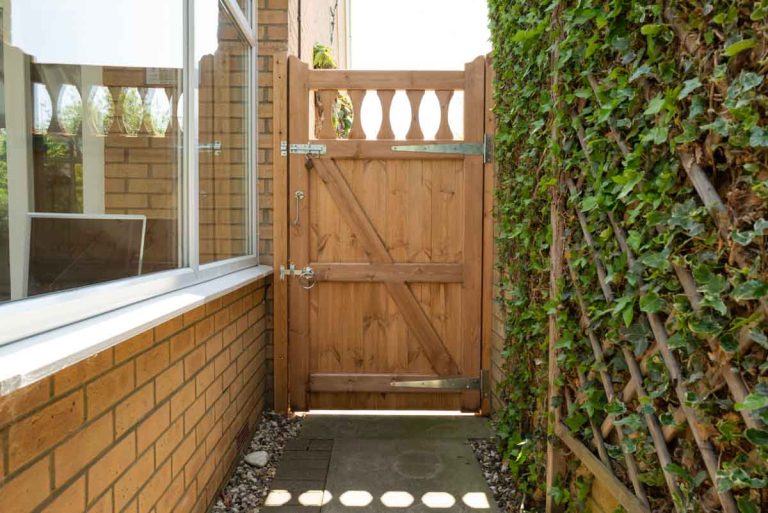Fence Stain vs Paint (Pros and Cons & Design Guide)

There are two popular finishes that you can apply to your fences: stain and paint. Either one can enhance the beauty of your fence and add a layer of protection for longevity.
Think of your fence as the final piece in your home. It offers security and privacy and sets boundaries among your neighbors. And finally, it carries a visual weight to your overall fence designs.
However, good-quality fences are a pricey investment for homeowners. With these in mind, choosing the right aesthetic finish can be daunting. The question is: should you choose stain or paint? Read on to learn more about the pros and cons of fence stain vs paint.
Here is a quick list of the pros and cons of staining and painting a fence:
| Pros of Staining a Fence | Cons of Staining a Fence |
| Preserves or enhances the wood’s natural features | Not all wood can be stained |
| Slows aging on wood | Can be difficult to re-stain |
| Less prone to decay | Stain takes a long time to dry |
| Easy to apply | |
| Pros of Painting a Fence | Cons of Painting a Fence |
| Paint comes in a variety of colors | Paint can peel off |
| Paint covers your fence’s imperfections | Paint is a toxic hazard |
| Paint is versatile |
Pros and Cons of Staining a Fence
A stain is likely to initiate changes in the composition of wood surfaces. This is because a stain seeps through the grain and blends in with the wood’s natural color.
Pros of Staining

Stain Preserves or Enhances the Wood’s Natural Features – Stains come in varying opacity, from clear to solid colors.
You can choose to keep the natural looks of the wood using clear to semi-opaque stains. Many homeowners prefer the unique texture and rich brown hues of their wood fence to stand out.
If you would like to see a pop of color that’s different from the wood, pick solid-colored stains. These are mostly available in primary colors.
Unlike paint, a solid-colored stain doesn’t cover up the natural texture or grains of the wood thus adding a rustic appeal.
Stain Slows Aging on Wood – It is only natural for wood to age, but a dull and damaged fence is not a good look. [Source: Publisher of Open Access Journals, Wood Surface Finishing with Transparent Lacquers Intended for Indoor Use, and the Colour Resistance of These Surfaces during Accelerated Aging]
Much like human skin, wood can age from too much sunlight. This is where a stain comes in handy. The stain acts as a barrier from harmful UV rays to prevent the color of the wood from fading or greying quickly.
Depending on your location, you may want to purchase a stain specially made for extreme heat.
A Stained Fence is Less Prone to Decay – It’s no secret that wood can be particularly susceptible to water. Rain, snow, and mildew cause wood to warp, crack, and rot. [Source: British Columbia Ministry of Agriculture and Food, Wood Preservation on the Farm]
Applying stain on your bare wood fence prevents these problems from happening. It can also deter termites.
Stain is Easy to Apply – Applying wood stain is pretty straightforward. Most stains are a two-in-one combo of sealer and stain. If your wood is easy to work with, it only takes one coat to finish the job.
Cons of Staining
Not all Wood Can Be Stained – There are types of wood that are particularly resistant to stain. Wood that has tighter pores and uneven grain patterns will not absorb the stain. Some examples include birch and maple.
It Can Be Difficult to Re-stain – You have to be careful when choosing your wood stain. If you plan on re-staining to another color, keep in mind that you’ll first need to remove the top finish. Doing so would allow the easier absorption of the stain.
On another note, re-staining from dark to light wood stain can also be tricky.
Stain Takes a Long Time to Dry – Depending on the type of stain you use, some stains take two to three days to completely dry up.
For this reason, it’s best to schedule your project when the sun’s out to avoid the hassle of redoing it.
Pros and Cons of Painting a Fence

If you fancy fully opaque colors or if your stained fence needs a new look, you might want to consider painting your fence. Below are the advantages and disadvantages of painting your fence.
Pros of Painting
Paint Comes in a Variety of Colors – Unlike wood stain, you have the freedom to pick all kinds of colors when you choose wood paint. This works in your favor if you want to customize and add a pop of vibrant color to your yard.
The all-time wood paint favorites include white, black, gray, and different shades of blue.
Paint Covers Your Fence’s Imperfections – Painting does a better job covering scratches, shallow and tiny holes, and uneven wood tone than stain.
This is especially helpful if you want to give a fresh and cleaner look to your old and weathered fence.
Paint containing mildewcides, when properly applied to a clean surface, should prevent mildew problems for some time- Daniel L. Cassens and William C. Feist, Finishing Wood Exterior
Paint Is Versatile – Paint adheres to many fence materials. Whether it be tight or open-pored softwood and hardwood or metal, paint can coat it all.
Cons of Painting
Paint Can Peel Off – A major drawback of painting is it can flake and peel off, leaving your fence looking patchy and messy.
This is why a primer on the surface is necessary before painting. This ensures higher pigmentation as the surface is prepped and lesser chances for it to peel off quicker than it should.
Paint Is a Toxic Hazard – The chemical content in exterior paints is high. These volatile organic compounds or VOCs may cause health problems according to the EPA with long-term exposure. It also stays in the soil for many years.
It’s a good idea to seek out low-VOC exterior paint options if possible. There are more expensive, but low-VOC paints are available to purchase that produce fewer fumes.
Paint May Not Meet The Standards of an HOA – If you live in an area with a homeowners association they may have certain guidelines about painting your exterior areas. Make sure to check with the local CCRs or covenants, conditions, and restrictions to be in compliance and avoid wasting time and money.
Is It Better to Stain or Paint the Fencing?

The choice of whether to stain or paint your fence ultimately relies on several factors, including the following:
Type of Wood. Rare and beautiful hardwood usually looks better when stained rather than painted. A stain allows the wood’s natural aesthetics to stand out with all its grains and texture.
Ask for samples if you plan to use a semi-transparent to opaque stain. Consider how it will look when it mixes with the natural color of the wood.
Surface Condition. Stain works great with new wood, whereas paints do a better job at covering cracks and holes on the surface of old wood.
Landscape and Design: Your fence should match your home exterior. Sometimes, a black-painted fence ties up all the design elements of your home better than a stained fence. Whether you have a stained or painted fence can also influence your decision for a harmonious backyard design.
Weather and Temperature Variations. Paint and stain are formulated to be weatherproof, but with slight differences.
Because stain seeps more into the wood, it allows the wood to breathe and allows moisture to move through the wood. However, wood paints serve as a better barrier against UV rays.
When comparing fence stain vs paint, it’s helpful to consider the specific area you live in. Painting provides better protection than stains against mold and sun damage and offers better rot resistance.
Does Paint or Stain Last Longer?
Paint typically lasts longer than stain. Due to its higher pigmentation, and also protects the fence against UV rays better than a dark-colored stain. That said, it’s not a hard and fast rule.
The longevity of stain or paint on your fence will vary by the type and condition of the wood as well as temperature variations. Some hardwood, like cedar, is already weatherproof and does not rot easily. Such material does fine with stains.
Under normal conditions, the stain applied to a fence can last between one and eight years. If the stain fades, it does so evenly.
We recommend a retouch every two to three years or as soon as you notice the wood starting to absorb water.
Paint, on the other hand, lasts from five to 10 years. Follow the proper steps in wood prepping to avoid the flaking and peeling of the paint. If the paint starts to crack and wear, it’s time for a fresh coat.
One major factor in prolonging the life of your wood fence is regular cleaning. Whether stained or painted, a clean fence reduces the chances of damage.
Which Is Cheaper?
When it comes to fence stain vs paint, you’ll find that painting is more expensive than a wood stain.
On average, paint costs $36 per gallon, while stain costs $24 per gallon. Choosing painting will also mean additional costs for the materials to prep the wood and labor if you hire a professional painter.
Paints that contain a primer are available for purchase but can be pricey. It does save you time and maintenance costs in the long run.
Most stains are easy to apply by hand, while paints need special tools to achieve a more professional and even look.
Best Type of Paint for a Fence

The best paint type depends on the surface you will be working on and other external elements. Here are the two best types to consider.
Oil-Based Paint
Oil-based paint is known to be the most durable application. It can handle the daily abuse from the sun and rain. This is not the most eco-friendly choice, and stripping it off can be difficult. It also takes a few days for it to dry completely.
Latex Paint
This type of paint is best when the weather is unpredictable since it only needs one to two hours to dry up.
You also do not have to worry about the temperature when applying because latex paint adapts to it. Since latex paints are water-soluble, it’s easy to wash off if you make a mistake during application. It’s also less likely to crack than oil-based paints.
There are hybrid versions of exterior latex paint that are as durable as oil-based paint, although these are more expensive.
Best Type of Stain To Use For Fences
Similar to paint, wood stain comes in a plethora of choices. And your option is narrowed down to what works with the fence material and exposure to harmful elements.
Oil-Based Stain
An oil-based stain is thick and penetrates deeper into the wood. It also prevents external elements, like UV rays and moisture, from damaging the wood.
Expect to wait two to three days for the oil-based stain to dry completely. Although that may be a long wait, oil-based stains require less maintenance than water-based stains. This is your best bet if your fence is constantly exposed to harsh weather.
Water-Based Stain
Water-based stains are lighter and easier to apply on wood surfaces. It dries quickly and maintains its pigments longer than oil-based stains. A bonus: the smell is not as pungent as the others.
The quick-dry formula of this stain is convenient for any situation, whether it is sunny or not.
The other types of exterior wood stains that you can check out are:
- Gel Stain
- Lacquer Stain
- Water-soluble dye stain
- Metalized dye stain
What is your favorite when it comes to fence stain vs paint? Let us know why you think fence paint or stain is best in the comments. For help visualizing your fencing before buying any materials, there are numerous fence design software programs that can help.






